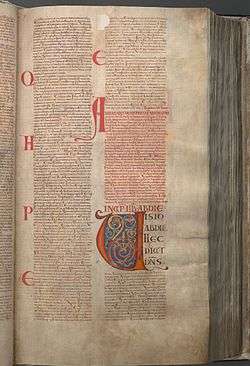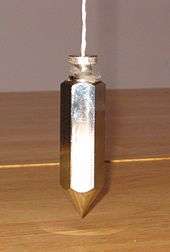Amos 7
Amos 7 is the seventh chapter of the Book of Amos in the Hebrew Bible or the Old Testament of the Christian Bible.[1][2] This book contains the prophecies attributed to the prophet Amos; in particular, the seventh, eighth, and ninth chapters contain visions and their explanations.[3] It is a part of the Book of the Twelve Minor Prophets.[4][5]
| Amos 7 | |
|---|---|
 | |
| Book | Book of Amos |
| Category | Nevi'im |
| Christian Bible part | Old Testament |
| Order in the Christian part | 30 |
Text
The original text was written in Hebrew language. This chapter is divided into 17 verses.
Textual witnesses
Some early manuscripts containing the text of this chapter in Hebrew are of the Masoretic Text tradition, which includes the Codex Cairensis (895), the Petersburg Codex of the Prophets (916), Aleppo Codex (10th century), Codex Leningradensis (1008).[6] Fragments cumulatively containing all verses of this chapter in Hebrew were found among the Dead Sea Scrolls including 4Q78 (4QXIIc; 75–50 BCE) with extant verses 1–16;[7][8][9] 4Q82 (4QXIIg; 25 BCE) with extant verses 1, 7–12, 14–17;[8][10][11] DSS F.Amos1 (DSS F.181; 1–30 CE) with extant verse 17;[8][12] and Wadi Murabba'at (MurXII; 75–100 CE) with extant verses 3–6, 8–17.[8]
There is also a translation into Koine Greek known as the Septuagint, made in the last few centuries BCE. Extant ancient manuscripts of the Septuagint version include Codex Vaticanus (B; B; 4th century), Codex Alexandrinus (A; A; 5th century) and Codex Marchalianus (Q; Q; 6th century).[13][lower-alpha 1]
Verse 8

- And the Lord said unto me,
- Amos, what seest thou?
- And I said, A plumbline.
- Then said the Lord,
- Behold, I will set a plumbline in the midst of my people Israel:
- will not again pass by them any more:[15]
- "Amos, what seest thou?" He calls the prophet by name, as a familiar friend, known and approved by Him, as He said to Moses, "I know thee by name" Exodus 33:12, Exodus 33:17. For "the Lord knoweth them that are His. What seest thou?" 2 Timothy 2:19.[16]
- "I will set a plumb line in the midst of my people Israel" As it was built by rule and measure, so it should be destroyed. The line was used not only for building, but also for pulling down (see 2 Kings 21:13; Isaiah 34:11; Lamentations 2:8). And this should be done "in the midst" of the people, that all might be tried individually, and that all might acknowledge the justice of the sentence, which now denounced complete ruin.[17]
- "Plumbline" or "plumb bob"; "plummet": the same word as before, and is differently rendered, as already observed. The Vulgate Latin version renders it, "a plasterer's" or "mason's trowel"; with which they lay their plaster and mortar on in building: the Septuagint, an adamant: and which, by Pliny,[18] is called "anachites"; a word in sound near to this here used: the Targum renders it, "judgment": but Jarchi and Aben Ezra observe, that in the Arabic tongue it signifies lead or tin, as it does;[19] and so a line with lead at the end of it;[20]
- "Not … pass by … any more": "not forgive them any more" (Amos 8:2; Proverbs 19:11; Micah 7:18).[3]
See also
Notes
- The extant Codex Sinaiticus currently does not have the whole Book of Amos.[14]
References
- Collins 2014.
- Hayes 2015.
- Robert Jamieson, Andrew Robert Fausset; David Brown. Jamieson, Fausset, and Brown's Commentary On the Whole Bible. 1871.

- Metzger, Bruce M., et al. The Oxford Companion to the Bible. New York: Oxford University Press, 1993.
- Keck, Leander E. 1996. The New Interpreter's Bible: Volume: VII. Nashville: Abingdon.
- Würthwein 1995, pp. 35-37.
- Ulrich 2010, p. 607.
- Dead sea scrolls – Amos
- Fitzmyer 2008, p. 38.
- Ulrich 2010, pp. 606–608.
- Fitzmyer 2008, p. 39.
- Tov, Emanuel (2014) New Fragments of Amos. Dead Sea Discoveries 21:3–13.
- Würthwein 1995, pp. 73-74.
-

- Amos 7:8
- Barnes, Albert. Notes on the Old Testament. London, Blackie & Son, 1884. Reprint, Grand Rapids: Baker Books, 1998.

- Joseph S. Exell; Henry Donald Maurice Spence-Jones (Editors). The Pulpit Commentary. 23 volumes. First publication: 1890.

- Pliny. Nat. Hist. l. 3. c. 4.
- "plumbum, sive nigrum, sive album puriusque", Camusus; "plumbum et stannum", Ibn Maruph apud Golium, col. 176. Avicenna apud Castel. col. 161. Vid. Hottinger. Smegma Oriental. l. 1. c. 7. p. 122.
- John Gill. John Gill's Exposition of the Entire Bible. Exposition of the Old and New Testament. Published in 1746–1763.

Sources
- Collins, John J. (2014). Introduction to the Hebrew Scriptures. Fortress Press.CS1 maint: ref=harv (link)
- Fitzmyer, Joseph A. (2008). A Guide to the Dead Sea Scrolls and Related Literature. Grand Rapids, MI: William B. Eerdmans Publishing Company. ISBN 9780802862419.CS1 maint: ref=harv (link)
- Hayes, Christine (2015). Introduction to the Bible. Yale University Press.CS1 maint: ref=harv (link)
- Ulrich, Eugene, ed. (2010). The Biblical Qumran Scrolls: Transcriptions and Textual Variants. Brill.CS1 maint: ref=harv (link)
- Würthwein, Ernst (1995). The Text of the Old Testament. Translated by Rhodes, Erroll F. Grand Rapids, MI: Wm. B. Eerdmans. ISBN 0-8028-0788-7. Retrieved January 26, 2019.